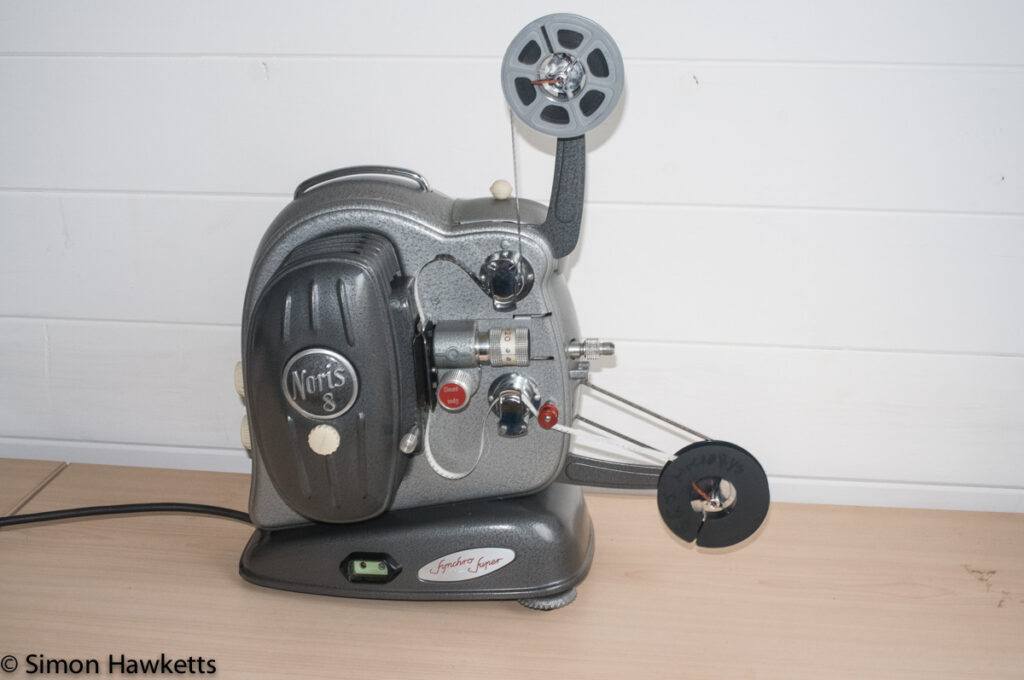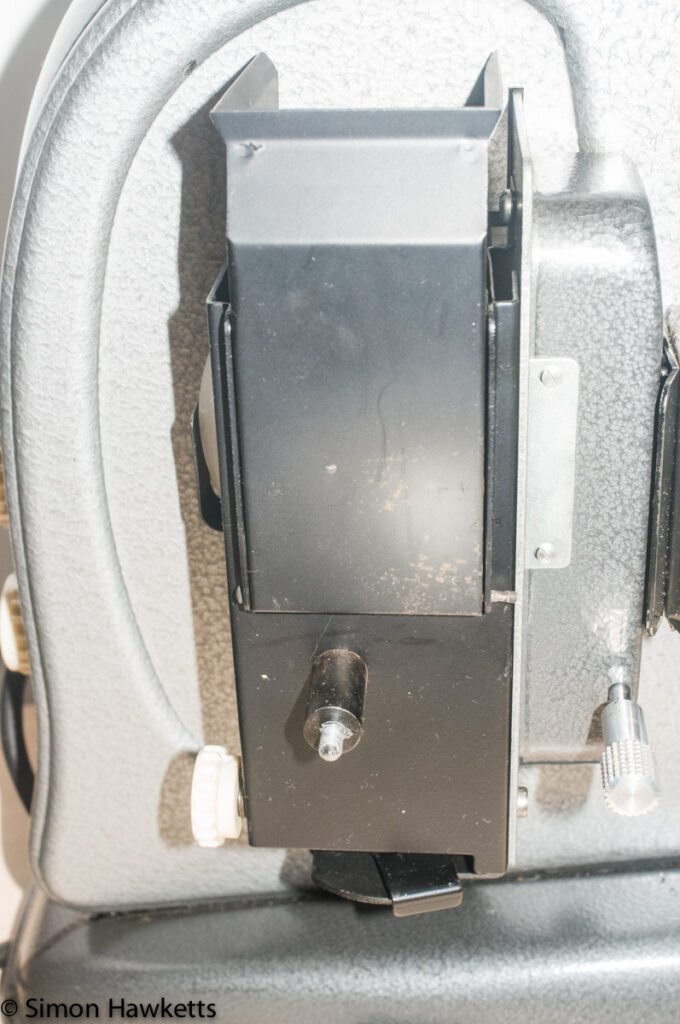The Beautiful Noris 8 Synchro Super projector
This article takes a look at the latest addition to my collection of 8 mm cine projectors, the Noris 8 Synchro Super.
My Noris 8 Synchro Super projector
I found this Noris 8 Synchro Super projector during an eBay search for ‘Vintage Projectors’ and decided I needed to try to buy it simply because of the ‘look’ of it. I’d heard of Noris of course, but I’d only seen the more modern Super 100 and Super 200 models, which look far less ‘vintage’ than the model described here.
The projector had a starting price of £29.99 and although that is quite high for a standard 8 projector, I think it stopped a lot of speculative bids which would have happened with a lower starting price, and therefore when I made a bid, with a few seconds to go, I managed to get it for that price.
The seller charged £10 for postage and packing, which I thought was excessive, but when the package turned up I decided that it was probably fair because they had taken a lot of effort to make sure the projector was well protected. Within a large cardboard box, there was a layer of bubble wrap around the projector case, and then the case itself had all the air spaces packed with bubble wrap to keep the unit safe.
Once I’d got it out of the packaging, I found the projector itself was in superb condition – almost like new. There is hardly a mark on the bodywork, and the optical path also seems clean and free of any corrosion.
Plugging the unit in confirmed that it is also fine from an operational point of view, so in the end I think the price I paid was probably pretty reasonable.
As a bonus, in the bottom of the projector case I found 3 standard 8 films, which had footage of various motor racing events which look to have been taken in the 1960s, so they are great content for my Vintage Home Movie site.
Pictures of the Noris 8 Synchro Super projector
The gallery here shows some images of the Projector.















Description of the Noris 8 Synchro Super Projector.
I’ve found it very difficult to find much information about the Noris 8 on-line, and unfortunately there wasn’t a handbook supplied with my projector, so the majority of what follows is my assessment and therefore may have some errors – apologies if that is the case.
My first assessment is that the quality of the projector seems to be top-notch. The materials used are very solid, and the crackle finish to the paintwork gives a very premium look to the unit.
Contrary to the name of the projector, it is made to project standard 8 mm films, not Super 8. Although I don’t know for certain the date that this projector was built, the design suggests that it was probably in the 1950s and Super 8 film was not introduced until 1965.
It is a very conventional design with two fold-out arms for the film spools, a couple of drive sprockets, one before the film gate and one after, and a lamp housing at the back of the projector body. The path to thread the film is fairly obvious, but the picture here is included for confirmation.
In terms of user controls, there are two knobs on the back of the unit that turn on the motor and then the lamp, and another control that adjusts the speed of the motor. Just under the film gate there is a small silvered knob which is used to set the framing (the position of the picture vertically) once the film is running.
I found these controls to be quite positive in action and the speed control gives a wide variation between what is obviously too fast, probably about 25 fps, down to quite a slow speed, possibly about 8 fps. There was actually a little more adjustment at the bottom end, but I didn’t want to risk burning the film by slowing it even more – suffice to say there is plenty of control.
There is no clutch or drive enable control on the projector, so you can’t project a square of light to get the focus set prior to projecting the film once it’s threaded – it’s basically a question of turning on and then quickly focussing the picture.
The film spools are driven by spring belts, at least the bottom one is – the top one has a drive belt supplied and the photo of the projector on eBay had it fitted between the top spool and the drive shaft that protrudes from the front of the projector. This however is how the projector rewinds a film after it has been shown – the drive belt to the bottom spool is removed, the film removed from the film gate and sprockets, and then the top spool is driven from this shaft to pull the film back to the feeder spool.
I don’t know how powerful the lamp fitted to the Noris 8 is1, but it is really bright and had no problem producing a small picture against the wall of my office during daylight, so I would think it would be great in a darkened room using a proper projection screen.
As well as the main controls, there are two additional adjustment controls inside the lamp housing which can be used to maximize the brightness of the lamp.
The small white knob can be rotated to raise and lower the lamp to make sure the point of maximum brightness is being used, and there is a small black metal lever that can be used to rotate the bulb holder for the same purpose – it makes sure the filament of the lamp is facing the film plane. These controls would not be adjusted during normal operation, they would have been set when the lamp was changed.
There are two mystery sets of sockets on the base, one on the front side and one on the back. They are a two pin connection which suggests that they may have been used to supply a small table lamp for the projectionist to see whilst threading the film2 . It was reasonably common to have these supply points, the Eumig P8 has a similar socket that is powered when the projector is off and then turns off when the projector starts, but I’m not sure why there would be two.
I’ve included a short video clip below of a film running through the Noris 8 just to show the projector running. Sometime in the near future I’ll produce a longer video review of the projector and when I do that I’ll replace this video. What I did want to just show however is how quiet the projector is when running and I hope that is apparent from this short clip.
Noris 8 Synchro Super Specifications
- Noris 8 Synchro Super standard 8 projector
- Made in the 1950s in Germany
- Very well made, solid construction and high quality projector
- Simple controls with a good speed range
- Very stylish, Art Deco look
- Projectionists lamp socket
- Very quiet operation
- Probably 500W lamp
- Lamp adjustment after change to get max brightness
- The fuse fitted to the base of the unit is 2.5A for a 250V input, which suggests the maximum power taken by the projector is about 700W, so it’s probably a 500W lamp [↩]
- In the 1950s and 1960s in the UK it was common to have a separate mains circuit just for low power lights that had a two pin socket [↩]
Discover more from Everything Vintage
Subscribe to get the latest posts sent to your email.

